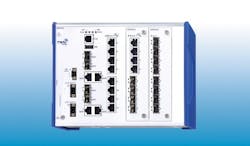Time Sensitive Networking (TSN)—an IEEE 802.1 standard created to bring determinism to standard Ethernet—is a concept that has been garnering a lot of attention over the past few years, particularly among engineers focused on industrial networking. 2017 stands poised to be the year TSN moves beyond being an engineering project and begins being deployed industrywide.
I say this because some of the first announcements about TSN-ready products and software updates for existing products are being prepared for release this year. As a case in point, Belden, a supplier of signal transmission products, is releasing a software update for its modularly-managed Hirschmann switch types RSPE35 and RSPE37 (shown in the image accompanying this article). This update, which Belden says will be available in the second half of 2017, will enable TSN features on those switches. In addition, older switches of both RSPE types can be upgraded for this new real-time technology.
According to Belden, the managed switches of the RSPE product family consist of a basic unit with eight twisted pair and four combo ports, which can be expanded through various media modules. The RSPE35 and RSPE37 versions support the Precision Time Protocol (PTP) in accordance with IEEE 1588-2008 and feature a Field Programmable Gate Array (FPGA) module, which means it's possible to implement selective hardware-based redundancy mechanisms such as High-availability Seamless Redundancy (HSR), Parallel Redundancy Protocol (PRP) and Device Level Ring (DLR) directly in the field. The new software update, which also enables TSN, can now be loaded into the FPGA as an alternative to previous redundancy mechanisms.
“For the first time, TSN allows a simultaneous transfer of time-critical and non-time-critical data with a guaranteed end-to-end latency via Ethernet in accordance with IEEE 802.1 and 802.3,” says Oliver Kleineberg, advanced development manager at Belden. “Because of the comprehensive functions and high bandwidths, the technology is suitable for nearly all automation applications. Moreover, since TSN is not a proprietary system like many other established real-time solutions, it can be used with devices from different manufacturers, which paves the way for the Industry 4.0 in modern heterogeneous industrial networks.”


